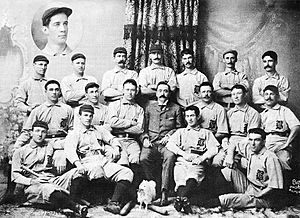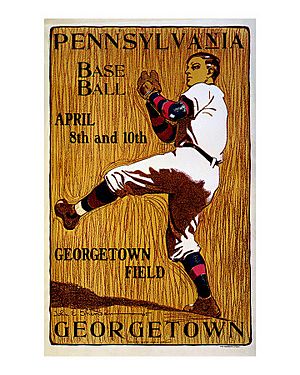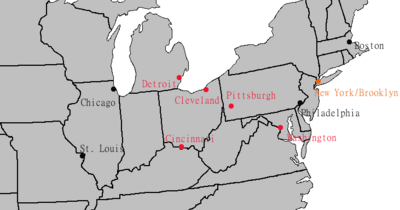History of baseball in the United States facts for kids

The history of baseball in the United States can be traced to the 19th century. This is when amateurs played a baseball-like game by their own informal rules using equipment they made themselves. The popularity of the sport inspired the semi-pro national baseball clubs in the 1860s.
Contents
Early history
The earliest known mention of baseball in the United States was a 1791 Pittsfield, Massachusetts, law banning the playing of the game within 80 yards (73 m) of the town meeting house. In 1903, the British sportswriter Henry Chadwick wrote an article saying that baseball came from a British game called rounders. A game which Chadwick had played as a boy in England. But baseball executive Albert Spalding disagreed. Baseball, said Spalding, was basically an American sport and began in America. To decide they agreed to let Abraham G. Mills settle the question by heading a commission. After three years they found that Abner Doubleday had invented the national pastime.
In 2004, baseball historian John Thorn discovered the 1791 town ordinance, putting Pittsfield's connection to baseball 48 years before Abner Doubleday accepted invention of the game in 1839 in Cooperstown, New York. This is where the National Baseball Hall of Fame now stands. The Hall of Fame recognized the ordinance as the first known reference to the game and honored the town with a plaque. Another early reference reports that base ball was regularly played on Saturdays in 1823 just outside of New York City in an area that today is Greenwich Village.
Growth
Before the Civil War, baseball competed for public interest with cricket and regional variants of baseball.
In the 1860s, aided by the war, "New York" style baseball expanded into a national game. As its first governing body, the National Association of Base Ball Players was formed. By 1867, it ballooned to over 400 members, including some clubs from as far away as San Francisco and Louisiana. One of these clubs, the Chicago White Stockings, won the championship in 1870. Today known as the Chicago Cubs, they are the oldest team in American organized sports. Because of this growth, regional and state organizations began to assume a more prominent role in the governance of the sport.
Professionalism
The Cincinnati Red Stockings were the first to so declare themselves as openly professional, and were easily the most aggressive in recruiting the best available players. Twelve clubs, including most of the strongest clubs in the NABBP, ultimately declared themselves professional for the 1869 season.
Rise of the major leagues

In 1870, a schism developed between professional and amateur ballplayers. The NABBP split into two groups. The National Association of Professional Base Ball Players operated from 1871 through 1875, and is considered by some to have been the first major league. Its amateur counterpart disappeared after only a few years.
The early years of the National League were tumultuous, with threats from rival leagues and a rebellion by players against the hated "reserve clause", which restricted the free movement of players between clubs. Competitive leagues formed regularly, and also disbanded regularly. For several years, the National League and American Association champions met in a postseason championship series—the first attempt at a World Series.
Western League began play in April 1894 with teams in Detroit (the only league team that has not moved since), Grand Rapids, Indianapolis, Kansas City, Milwaukee, Minneapolis, Sioux City and Toledo. Prior to the 1900 season, the league changed its name to the American League and moved several franchises to larger, strategic locations. In 1901 the American League declared its intent to operate as a major league.
The resulting bidding war for players led to widespread contract-breaking and legal disputes.
The war between the American and National caused shock waves throughout the baseball world. At a meeting in 1901, the other baseball leagues negotiated a plan to maintain their independence. On September 5, 1901 Patrick T. Powers, president of the Eastern League announced the formation of the second National Association of Professional Baseball Leagues, the NABPL or "NA" for short.

After 1902 both leagues and the NABPL signed a new National Agreement which achieved three things:
- First and foremost, it governed player contracts that set up mechanisms to end the cross-league raids on rosters and reinforced the power of the hated reserve clause that kept players virtual slaves to their baseball masters.
- Second, it led to the playing of a "World Series" in 1903 between the two major league champions. The first World Series was won by Boston of the American League.
- Lastly, it established a system of control and dominance for the major leagues over the independents.
In the very early part of the 20th century, known as the "dead-ball era", baseball rules and equipment favored the "inside game" and the game was played more violently and aggressively than it is today. This period ended in the 1920s with several changes that gave advantages to hitters. In the largest parks, the outfield fences were brought closer to the infield. In addition, the strict enforcement of new rules governing the size, shape and construction of the ball caused it to travel farther.
The first professional black baseball club, the Cuban Giants, was organized in 1885. Subsequent professional black baseball clubs played each other independently, without an official league to organize the sport. Rube Foster, a former ballplayer, founded the Negro National League in 1920. A second league, the Eastern Colored League, was established in 1923. These became known as the Negro Leagues, though these leagues never had any formal overall structure comparable to the Major Leagues. The Negro National League did well until 1930, but folded during the Great Depression.
From 1942 to 1948, the Negro League World Series was revived. This was the golden era of Negro League baseball, a time when it produced some of its greatest stars. In 1947, Jackie Robinson signed a contract with the Brooklyn Dodgers, breaking the color barrier that had prevented talented African American players from entering the white-only major leagues. Although the transformation was not instantaneous, baseball has since become fully integrated. In 1948, the Negro Leagues faced financial difficulties that effectively ended their existence.
Pitchers dominated the game in the 1960s and early 1970s. In 1973, the designated hitter (DH) rule was adopted by the American League, while in the National League pitchers still bat for themselves to this day. The DH rule now constitutes the primary difference between the two leagues.
During the late 1960s, the Baseball Players Union became much stronger and conflicts between owners and the players' union led to major work stoppages in 1972, 1981, and 1994. The 1994 baseball strike led to the cancellation of the World Series, and was not settled until the spring of 1995. In the late 1990s, functions that had been administered separately by the two major leagues' administrations were united under the rubric of Major League Baseball.
The dead-ball era: 1900 to 1919
At this time the games tended to be low scoring, dominated by such pitchers as Walter Johnson, Cy Young, Christy Mathewson, and Grover Cleveland Alexander to the extent that the period 1900–1919 is commonly called the "Dead-ball era". The term also accurately describes the condition of the baseball itself. Baseballs cost three dollars apiece, which in 1900 would be equal to $106 today; club owners were therefore reluctant to spend much money on new balls if not necessary. It was not unusual for a single baseball to last an entire game. By the end of the game, the ball would be dark with grass, mud, and tobacco juice, and it would be misshapen and lumpy from contact with the bat. Balls were only replaced if they were hit into the crowd and lost, and many clubs employed security guards expressly for the purpose of retrieving balls hit into the stands—a practice unthinkable today.
As a consequence, home runs were rare, and the "inside game" dominated—singles, bunts, stolen bases, the hit-and-run play, and other tactics dominated the strategies of the time.
Despite this, there were also several superstar hitters, the most famous being Honus Wagner, held to be one of the greatest shortstops to ever play the game, and Detroit's Ty Cobb, the "Georgia Peach." His career batting average of .366 has yet to be bested.
The first international leagues
While many of the players that made up the black baseball teams were African-Americans, many more were Latin Americans from nations that deliver some of the greatest talents that make up the major league rosters of today. Black players moved freely through the rest of baseball, playing in Canadian Baseball, Mexican Baseball, Caribbean Baseball, and Central America and South America where more than a few found that level of fame that they were unable to attain in the country of their birth.
The war years
In 1941, a year which saw the premature death of Lou Gehrig, Boston's great left fielder Ted Williams had a batting average over .400 – the last time anyone has achieved that feat. During the same season Joe DiMaggio hit successfully in 56 consecutive games, an accomplishment both unprecedented and unequaled.
After the United States entered World War II after the attack on Pearl Harbor, Landis asked Franklin D. Roosevelt whether professional baseball should continue during the war. In the "Green Light Letter", the US president replied that baseball was important to national morale, and asked for more night games so day workers could attend. Thirty-five Hall of Fame members and more than 500 Major League Baseball players served in the war, but with the exception of D-Day games continued. Both Williams and DiMaggio would miss playing time in the services, with Williams also flying later in the Korean War. During this period Stan Musial led the St. Louis Cardinals to the 1942, 1944 and 1946 World Series titles.
The war years also saw the founding of the All-American Girls Professional Baseball League.
Baseball boomed after World War II. 1945 saw a new attendance record and the following year average crowds leapt nearly 70% to 14,914. Further records followed in 1948 and 1949, when the average reached 16,913. While average attendances slipped to somewhat lower levels through the 1950s, 1960s and the first half of the 1970s, they remained well above pre-war levels, and total seasonal attendance regularly hit new highs from 1962 onwards as the number of major league games increased.
Racial integration in baseball
From 1947 to the 1970s, African American participation in baseball rose steadily. By 1974, 27% of baseball players were African American. As a result of this on-field experience, minorities began to experience long-delayed gains in managerial positions within baseball. In 1975, Frank Robinson (who had been the 1956 Rookie of the Year with the Cincinnati Reds) was named player-manager of the Cleveland Indians, making him the first African American manager in the major leagues.
Arturo Moreno became the first Hispanic owner of a MLB franchise when he purchased the Anaheim Angels in 2004.
Sponsorships, endorsements and merchandise
Television and greater media coverage in magazines and newspapers trying to attract a new generation of non-readers also brought in the sponsors, and even more money, that would attract players to new financial opportunities and bring in other elements to the business of baseball that would impact the game.
Baseball memorabilia and souvenirs, including baseball cards, exploded in price as networks of adults became more sophisticated in their trading. This would explode yet again in the late 1990s, as the Internet, and the website eBay provided venues for collectors of all things baseball to trade with each other. Regionalized pricing was wiped away, and many objects, baseballs, bats, and the like began selling for high dollar values. This in turn brought in new businessmen whose sole means of making a living was acquiring autographs and memorabilia from the athletes. Memorabilia hounds fought with fans to get signatures worth $20, $60, or even $100 or more in their stores.
Beyond the staple billboards, large corporations like NIKE and Champion fought to make sure that their logos were seen on the clothing and shoes worn by athletes on the field. This kind of association branding became a new revenue stream. In the late 1990s and into the dawn of the 21st century, the dugout, the backstops behind home plate, and anywhere else that might be seen by a camera all became fair game for inserting advertising.
Images for kids
-
Baseball Players Practicing, by Thomas Eakins (1875)
-
Babe Ruth in 1920.
-
Hall of Famer Sandy Koufax, who refused to re-sign his contract in 1966
-
Mark McGwire hits a home run during his last Major League season in 2001
-
To meet the Power Age, Citi Field in New York was built to favor teams built on pitching, defense, and speed.














